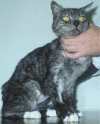Feline alimentary lymphoma: 1. Classification, risk factors, clinical signs and non-invasive diagnostics
- PMID: 22370860
- PMCID: PMC10822432
- DOI: 10.1177/1098612X12439265
Feline alimentary lymphoma: 1. Classification, risk factors, clinical signs and non-invasive diagnostics
Abstract
Practical relevance: Alimentary lymphoma (AL) occurs commonly in cats and exists as distinct subtypes that differ in their clinical course, response to treatment and prognosis. Accurate diagnosis is important to guide appropriate treatment.
Clinical challenges: Differentiation of low-grade alimentary lymphoma from lymphoplasmacytic enteritis can be challenging, especially where endoscopic intestinal biopsies, which sample only the mucosa and submucosa, are used. The major differentials for intermediate- and high-grade alimentary lymphoma are other neoplastic and non-neoplastic intestinal mass lesions. The diagnosis of large granular lymphocyte lymphoma requires vigilance as it may be missed with routine diagnostics.
Patient group: AL affects predominantly middle- to old-aged domestic crossbred cats (median age 10-13 years).
Evidence base: The evidence supporting this review is grade II, III and IV, derived from prospective studies, retrospective case series, reviews, extrapolation from other species, pathophysiological justification and the combined clinical experience of those working in the field.
Conflict of interest statement
The authors declare that there is no conflict of interest.
Figures




References
-
- Valli VE, Jacobs RM, Norris A, Couto CG, Morrison WB, et al. . The histologic classification of 602 cases of feline lymphoproliferative disease using the National Cancer Institute working formulation. J Vet Diagn Invest 2000; 12: 295–306. - PubMed
-
- Rissetto K, Villamil JA, Selting KA, Tyler J, Henry CJ. Recent trends in feline intestinal neoplasia: an epidemiologic study of 1129 cases in the Veterinary Medical Database from 1964 to 2004. J Am Anim Hosp Assoc 2011; 47: 28–36. - PubMed
-
- Mahony OM, Moore AS, Cotter SM, Engler SJ, Brown D, Penninck DG. Alimentary lymphoma in cats: 28 cases (1988–1993). J Am Vet Med Assoc 1995; 207: 1593–1598. - PubMed
-
- Gabor LJ, Malik R, Canfield PJ. Clinical and anatomical features of lymphosarcoma in 118 cats. Aust Vet J 1998; 76: 725–732. - PubMed
-
- Vail DM, Moore AS, Ogilvie GK, Volk LM. Feline lymphoma (145 cases): proliferation indices, cluster of differentiation 3 immunoreactivity, and their association with prognosis in 90 cats. J Vet Intern Med 1998; 12: 349–354. - PubMed
Publication types
MeSH terms
LinkOut - more resources
Full Text Sources
Medical
Miscellaneous

